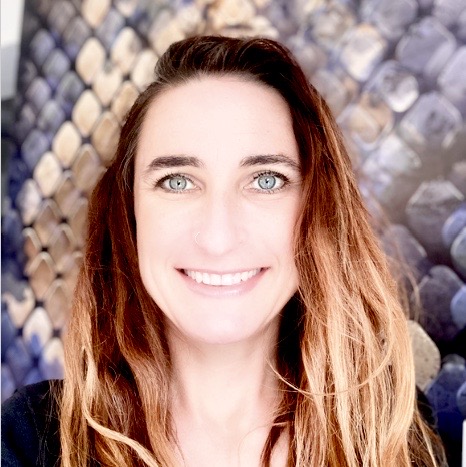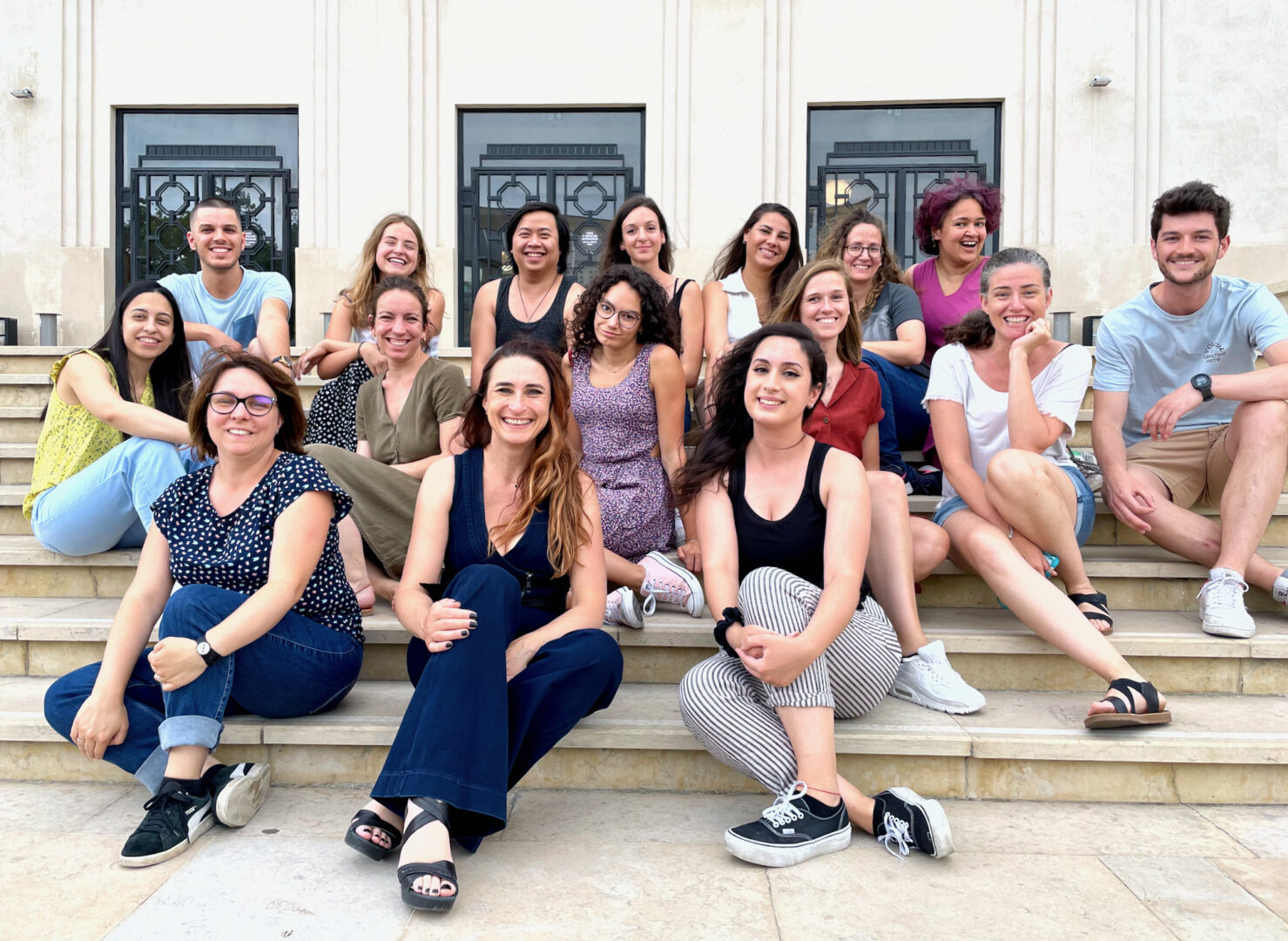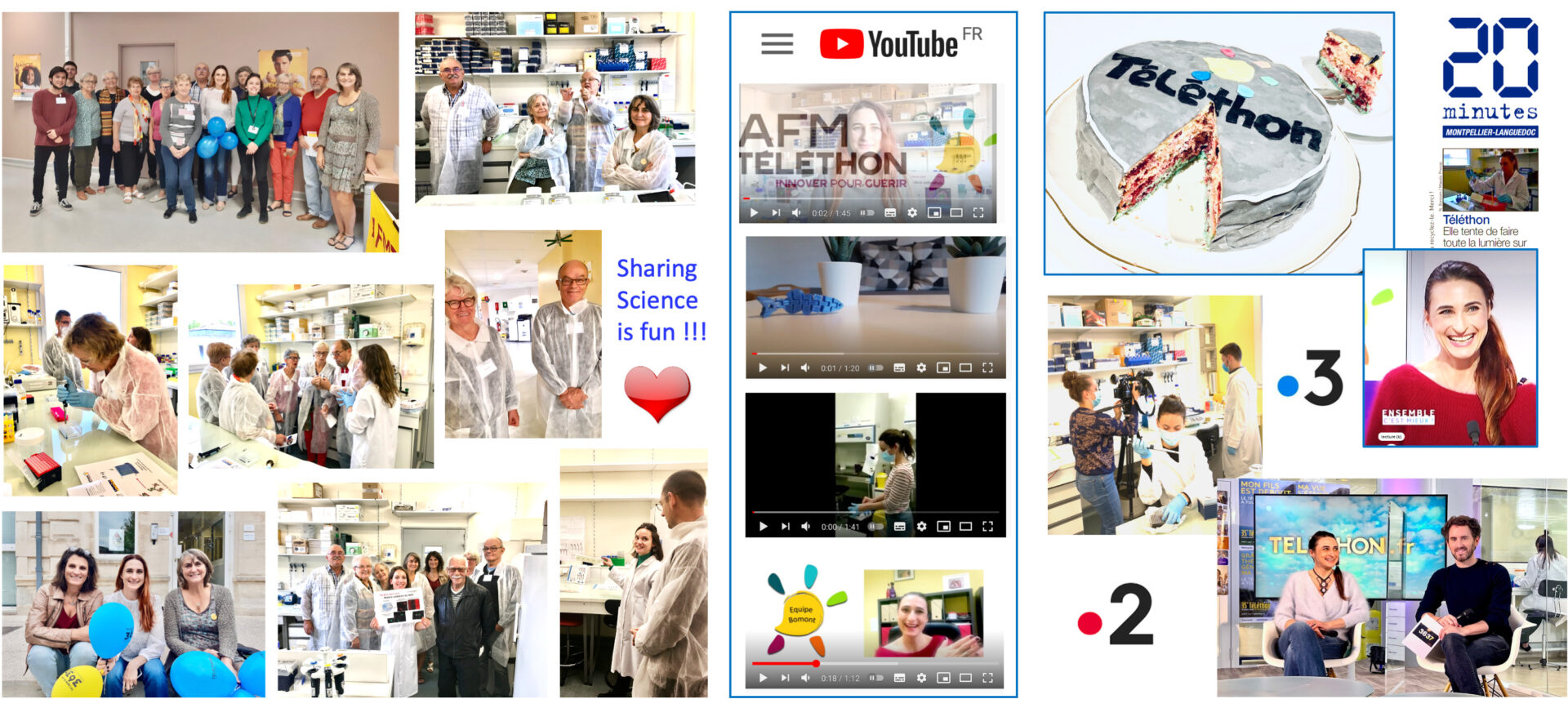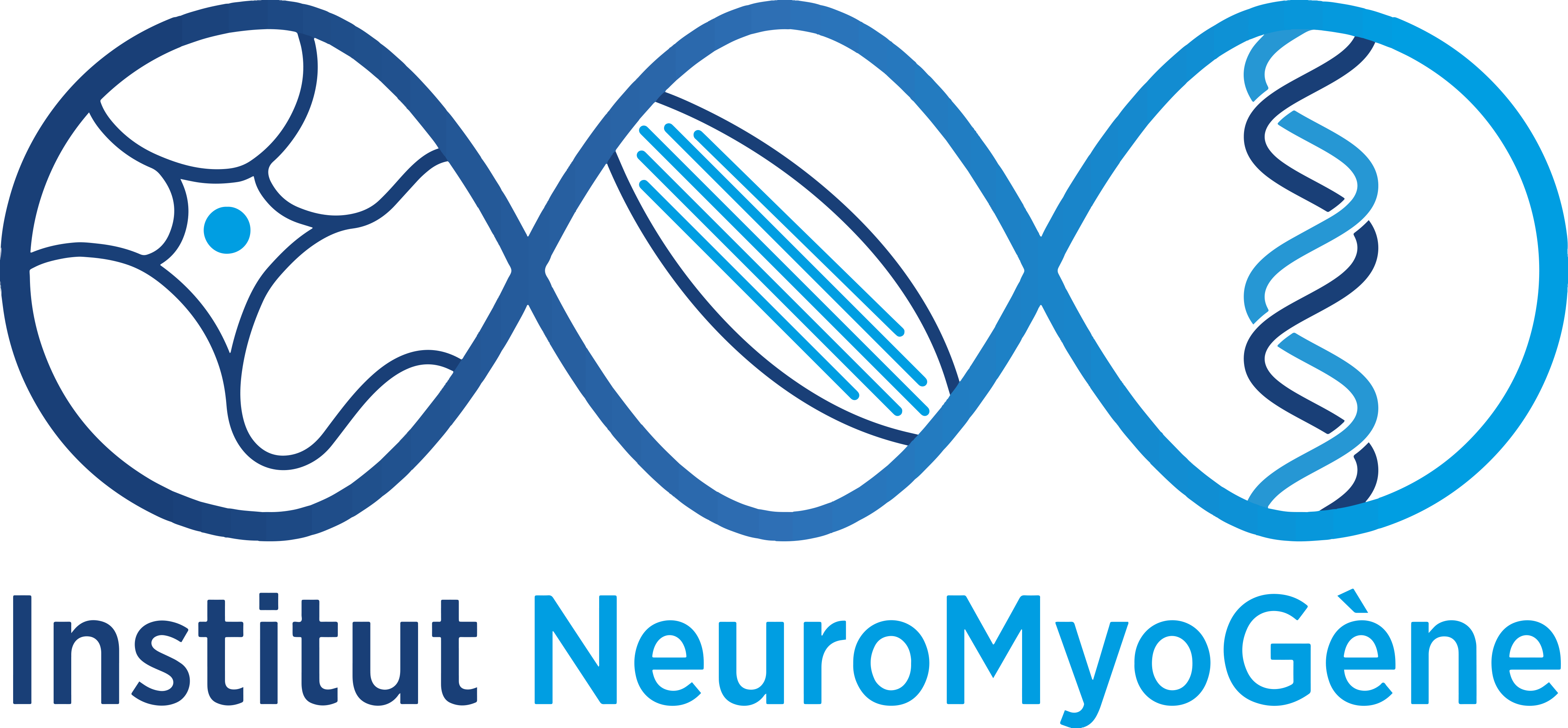
TEAM
- Pascale BOMONT
Research Director INSERM
- Elisabeth CORTIER
Engineer UCBL
- Caroline LIENARD
PHD STUDENT
- Farah KOTAICH
PHD STUDENT - Leticia ARIAS
Engineer INSERM
- Nourhane BOUCHEMA
Engineer CNRS
- Alexandra FERREIRA
Engineer CNRS
- Camille BONNET
Master II student
- Lenja DE COCK
ERASMUS student
PROJECTS
Our team studies the cellular and molecular basis sustaining neuronal integrity, and deciphers the mechanisms underlying neurodegeneration and/or developmental defects in disease. We combine fundamental and applied research, because we are convinced that the knowledge of the nervous system feeds therapeutic development, and reciprocally, that the study of diseases expands our knowledge of the basics. Our team is strongly engaged in the dissemination of science (fundamental & translational), and organizes/participates to numerous events for the public and patients.
Using a multidisciplinary approach encompassing genetics, cell biology, and physiology, the lab is permanently in a learning mode, seeking to explore new disciplines/systems that will help us answer our biological questions. In the last years, we have discovered the genetic loci and genes responsible for a number of neurological diseases, developed diagnostic tools and generated several pre-clinical models (patients derived cells, mouse and zebrafish) to tackle key cellular pathways for neuronal maintenance.
Initially focused on a fatal neurodegenerative disease called GAN (giant axonal neuropathy), for its wide alteration of the nervous system and generalized disorganization of the cytoskeleton, we identified the GAN gene and uncovered key roles of the encoded Gigaxonin-E3 ligase in controlling cytoskeletal architecture (Intermediate Filaments), autophagy machinery (ATG16L1) and neuronal identity (Shh signaling through Ptch). Overall, our team uncovered the repertoire of the molecular and cellular alterations underlying GAN pathophysiology, and now offers potential therapeutic targets for this fatal disease. Notably, our work on a rare disease has also contributed to a deeper understanding of fundamental cell- and neuro- biology. Moreover, these discoveries have a significant impact in health, as they can be of benefit to other neurological and non-neurological diseases.
Our scientific direction is to further tackle the biology of neuromuscular diseases, with a focus on GAN and Charcot-Marie-Tooth diseases. Specifically, we aim to unravel the regulations and functions of i) the cytoskeleton and ii) the autophagy pathway in normal neuronal physiology and disease states, and then translate this knowledge into therapies.
Three main axes are being pursued:
- Neurofilaments in health and neurodegenerative disease. In this project, we combine state-of-the-art live-imaging, proteomics and mathematic modelization to study the dynamics of neurofilaments in vivo, using zebrafish. Inclusion of disease contexts will pinpoint mechanisms triggering neurodegeneration and will constitute a significant platform for therapeutic interventions.
- Dynamics of autophagy within neurons. The project combines cell biology, live-imaging and biophysics, to study the spatial control of autophagy within neuron, and subsequent alterations in neurodegenerative diseases.
- Therapy for Giant Axonal Neuropathy. In this program, we will use the robust animal models (mouse & zebrafish) we generated for GAN. The goal is to conduct preclinical studies to evaluate the potential benefit of applying a gene therapy and/or a pharmacological approach for this fatal neuromuscular disease.
SELECTED PUBLICATIONS
- The dazzling rise of neurofilaments: Physiological functions and roles as biomarkers.
Bomont P. Curr Opin Cell Biol. (2021) Jan 13:S0955-0674(20)30146-0. doi: 10.1016/j.ceb.2020.10.011. Online ahead of print. - E3 Ubiquitin Ligases in Neurological Diseases: Focus on Gigaxonin and Autophagy.
Lescouzères L, Bomont P. Front Physiol (2020) 11:1022. - Neurofilaments: neurobiological foundations for biomarker applications.
Gafson AR, Barthélemy NR, Bomont P, Carare RO, Durham HD, Julien JP, Kuhle J, Leppert D, Nixon RA, Weller RO, Zetterberg H, Matthews PM. Brain (2020) 143(7):1975-1998. - Sonic Hedgehog repression underlies gigaxonin mutation-induced motor deficits in giant axonal neuropathy.
Arribat Y*, Mysiak KS*, Lescouzères L, Boizot A, Ruiz M, Rossel M, Bomont P. J Clin Invest. (2019) 129(12):5312-5326. - Gigaxonin E3 ligase governs ATG16L1 turn over to control autophagosome production.
Scrivo A, Codogno P, Bomont P. Nat Commun. (2019) 10(1):780. - Biallelic Variants in UBA5 Reveal that Disruption of the UFM1 Cascade Can Result in Early-Onset Encephalopathy.
Colin E*, (…), Bomont P*, Liebau E*, Bonneau D*. Am J Hum Genet. (2016) 99(3):695-703. - Recessive Mutations in RTN4IP1 Cause Isolated and Syndromic Optic Neuropathies.
Angebault C, (…), Rozet JM, Bomont P, Hamel CP, Lenaers G. Am J Hum Genet. (2015) 97(5):754-60. - Giant axonal neuropathy-associated gigaxonin mutations impair intermediate filament protein degradation.
Mahammad S, Murthy SN, Didonna A, Grin B, Israeli E, Perrot R, Bomont P, Julien JP, Kuczmarski E, Opal P, Goldman RD. J Clin Invest. (2013) 123(5):1964-75. - Mutations in the beta-tubulin gene TUBB2B result in asymmetrical polymicrogyria.
Jaglin XH, (…), Bomont P, Castelnau-Ptakhine L, Odent S, Loget P, Kossorotoff M, Snoeck I, Plessis G, Parent P, Beldjord C, Cardoso C, Represa A, Flint J, Keays DA, Cowan NJ, Chelly J. Nat Genet. (2009) 41(6):746-52. - Unstable microtubule capture at kinetochores depleted of the centromere protein CENP-F.
Bomont P, Maddox P, Shah JV, Desai AB, Cleveland DW. EMBO J. (2005) 24(22):3927-39. - Senataxin, the ortholog of a yeast RNA helicase, is mutant in ataxia-ocular apraxia 2.
Moreira MC, (…), Bomont P, Benhassine T, Bouslam N, Stevanin G, Brice A, Guimarães J, Mendonça P, Barbot C, Coutinho P, Sequeiros J, Dürr A, Warter JM, Koenig M. Nat Genet. (2004) 36(3):225-7. - The gene encoding gigaxonin, a new member of the cytoskeletal BTB/kelch repeat family, is mutated in giant axonal neuropathy.
Bomont P, Cavalier L, Blondeau F, Ben Hamida C, Belal S, Tazir M, Demir E, Topaloglu H, Korinthenberg R, Tüysüz B, Landrieu P, Hentati F, Koenig M. Nat Genet. (2000) 26(3):370-4.
JOB OFFERS
The spirit of the lab is to promote diversity and complementarity, at personal and professional levels. Acknowledging and respecting our differences, and building on those will make our journey fun and our research much richer! In our team, we mix 8 nationalities to grow as scientists and individuals… TOGETHER!

We are always seeking for enthusiastic and talented lab members. So if you like our thematic, please contact us (pascale.bomont@inserm.fr) and we will find a way to recruit you. Consider the following funding sources, that we can discuss together:
Postdoctoral researchers: Marie Skłodowska-Curie Fellowship, EMBO Postdoctoral Fellowship, HFSP Postdoctoral Fellowship,
PhD student: Eiffel scholarship; Doctoral school BMIC “Molecular, Integrative and Cellular Biology”
Master student: ERASMUS program
COMMIMENT/DISSEMINATION
Promoting science (fundamental & translational) is a strong commitment of the team. We organize and participate with enthusiasm to numerous events for the public and patient driven associations: Science Festival, Brain Week, Téléthon… Adapted to the message & the audience, our activities are on various formats: Twitter, YouTube, written press, television, conferences, workshops in the lab, teaching in schools ….

FUNDING
Grants
- ERC-CoG (2021-2026)
- AFM strategic project (2021-2024)
- AFM (2019-2022)
- AFM (2018-2022)
- Fondation Maladies Rares (2020-2022)
-
-
Fellowships
- FRM for L. Lescouzères
- AFM for F. Kotaich
- CHU for C. Liénard
-
-

AWARDS
- INSERM Scientific excellence (2021)
- INSERM Scientific excellence (2012)
- Senior “Christian Nezelof” prize (2012)
- ATIP-Avenir (2011)
-
-
Adresse
Institut NeuroMyoGène
UCBL–CNRS UMR 5310–INSERM U1217
Faculté de Médecine – 3ème étage – Aile C
8 Avenue Rockefeller – 69008 Lyon – France


